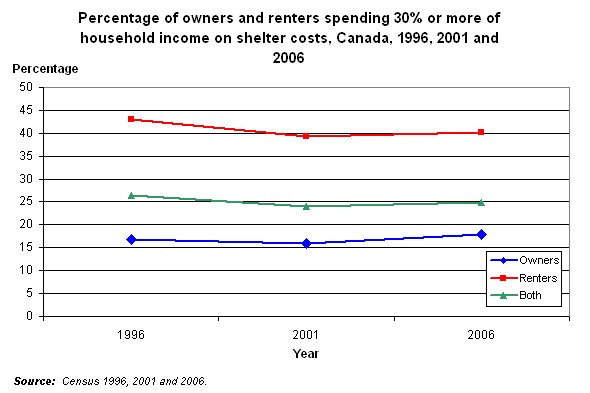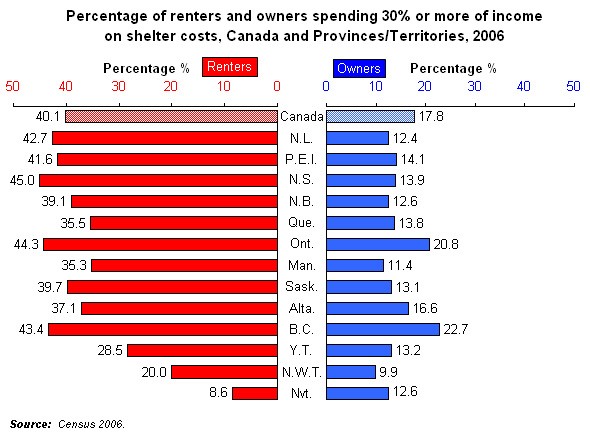Housing affordability
Archived Content
Information identified as archived is provided for reference, research or recordkeeping purposes. It is not subject to the Government of Canada Web Standards and has not been altered or updated since it was archived. Please "contact us" to request a format other than those available.
People in households that spend 30% or more of total household income on shelter expenses are defined as having a "housing affordability" problem. Shelter expenses include electricity, oil, gas, coal, wood or other fuels, water and other municipal services, monthly mortgage payments, property taxes, condominium fees, and rent. Band housing on Indian reserves was not included in the calculation of housing affordability.
Importance of indicator
People who lack access to acceptable housing are more likely than those with adequate housing to experience physical and mental health problems1. Acceptable housing is affordable, requires no major repairs, and is not overcrowded. Affordability is the most common problem. The indicator, housing affordability, identifies a sector of the population experiencing financial strain and, given their shelter costs, suffering the consequences of not having adequate funds available for necessities such as food, clothing and transportation. It is a relative measure that reflects the balance of income, living arrangements, and housing costs.
Background
The amount that families pay for housing reflects not only the size and quality of their home, but also, the type of neighbourhood and access to schools, jobs and community resources2.
Housing affordability problems are not evenly distributed among the population3,4.
In 2001, 18% of seniors had housing affordability problems3. Lower–income seniors are particularly vulnerable; from 1981 through 2001, the prevalence of housing affordability problems rose from 45% to 52% in this group3.
Seniors who live alone are more likely to have housing affordability problems as are seniors who are renters, residents of large cities, women, and older seniors (85 or older)3.
Housing affordability problems affect recent immigrants disproportionately, largely an effect of high housing costs in Toronto and Vancouver where many new immigrants initially settle3.
The prevalence of housing affordability problems is relatively high among people who live alone, female lone-parent families, and people who have experienced recent family changes (marriage, divorce, and the arrival of children, for example)4.
Between 2002 and 2004, people with a disability were more likely than those without a disability to have housing affordability problems4.
Highlights and graphs
Time trend
Description

- In 2006, 68% of the 12.2 million occupied private dwellings in Canada were owner-occupied (8.4 million); the remaining 32% (3.9 million) were rented5.
- One in four Canadian households (more than 3 million) spent at least 30% of their household income on shelter costs.
- The percentage of Canadian households in these circumstances has remained relatively stable since 1996.
- In 2006, 40% of renters, compared with 18% of owners, had a housing affordability problem.
Province
Description

- More than one in five owners living in Ontario and British Columbia had housing affordability issues.
- More than a third of renter households in every province faced high shelter costs; percentages were particularly high in Nova Scotia (45%), Ontario (44%) and British Columbia (43%).
References
1. Butler-Jones D. The Chief Public Health Officer's Report on the State of Public Health in Canada, 2008.
2. Luffman J. Measuring housing affordability. Perspectives on Labour and Income (Statistics Canada, Catalogue 75-001) November 2006; 7(11):16-25.
3. Clark W. What do seniors spend on housing? Canadian Social Trends. (Statistics Canada, Catalogue 11-008) Autumn 2005.
4. Rea W, Yuen J, Engeland J, Figueroa R. The dynamics of housing affordability. Perspectives on Labour and Income (Statistics Canada, Catalogue 75-001) January, 2008; 9(1):15-26
5. Statistics Canada. Census indicator profile, Canada, provinces, territories, health regions (December 2007 boundaries) and peer groups, every 5 years (CANSIM Table).
- Date modified:
